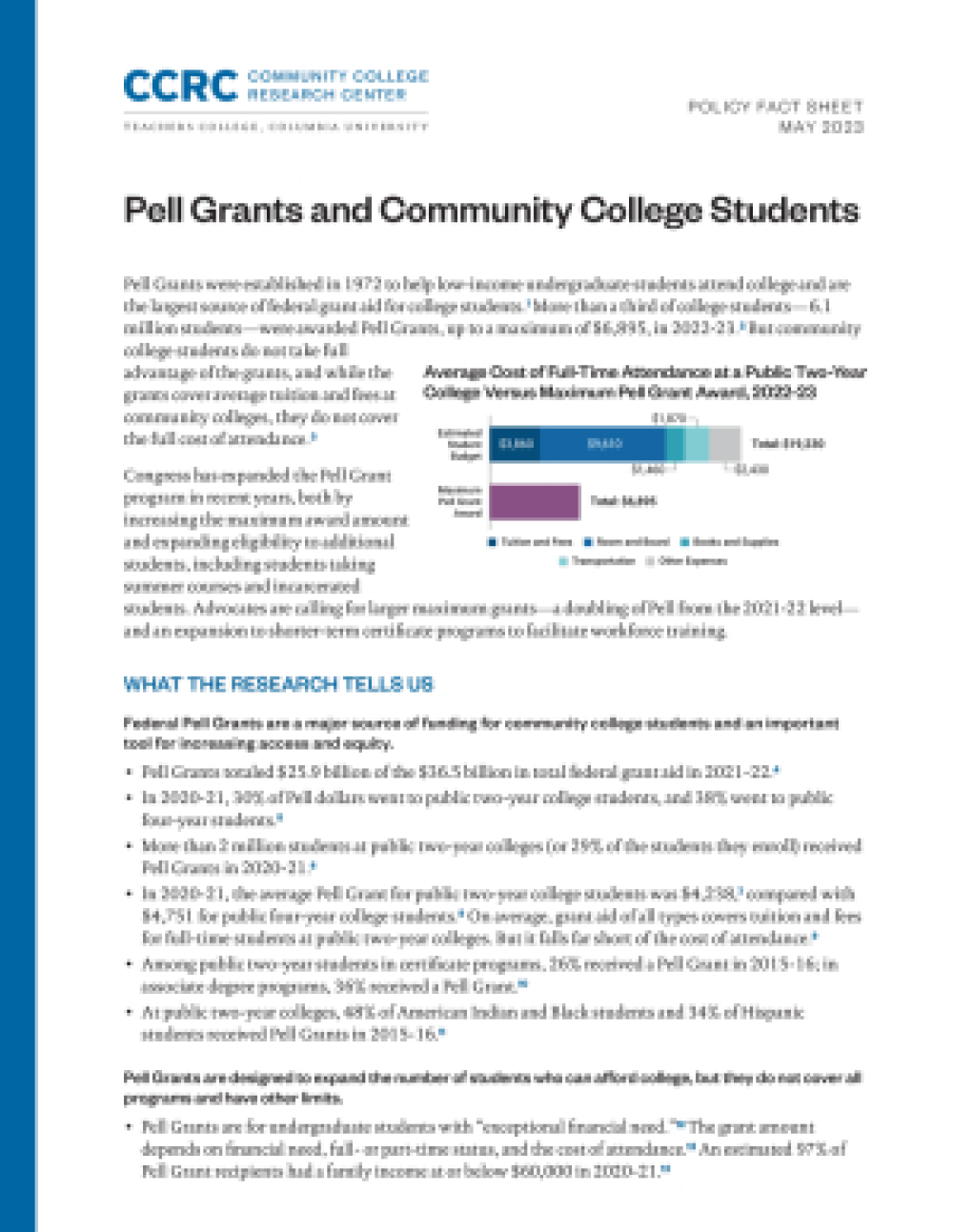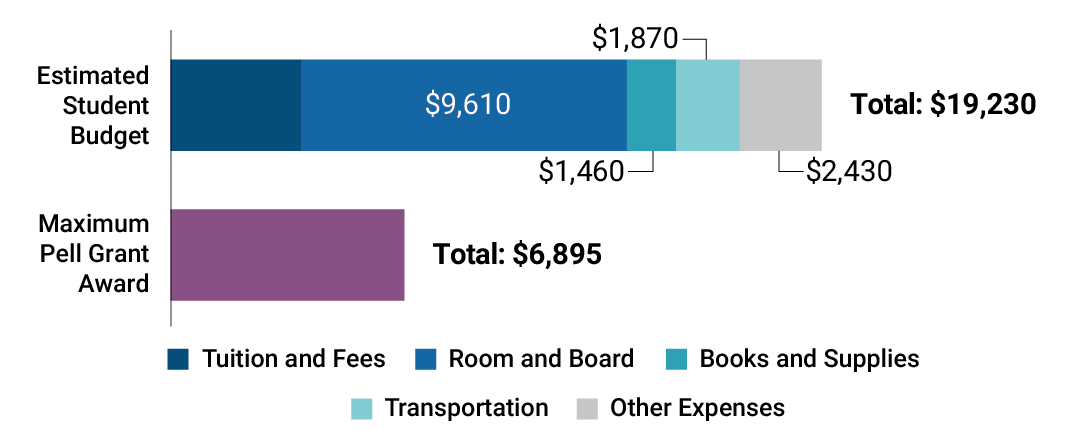
Pell Grants were established in 1972 to help low-income undergraduate students attend college and are the largest source of federal grant aid for college students.[1] More than a third of college students—6.1 million students—were awarded Pell Grants, up to a maximum of $6,895, in 2022-23.[2]But community college students do not take full advantage of the grants, and while the grants cover average tuition and fees at community colleges, they do not cover the full cost of attendance.[3]
Congress has expanded the Pell Grant program in recent years, both by increasing the maximum award amount and expanding eligibility to additional students, including students taking summer courses and incarcerated students. Advocates are calling for larger maximum grants—a doubling of Pell from the 2021-22 level— and an expansion to shorter-term certificate programs to facilitate workforce training.
Average Cost of Full-Time Attendance at a Public Two-Year College Versus Maximum Pell Grant Award, 2022-23

What the Research Tells Us
Federal Pell Grants are a major source of funding for community college students and an important tool for increasing access and equity.
- Pell Grants totaled $25.9 billion of the $36.5 billion in total federal grant aid in 2021-22.[4]
- In 2020-21, 30% of Pell dollars went to public two-year college students, and 38% went to public four-year students.[5]
- More than 2 million students at public two-year colleges (or 29% of the students they enroll) received Pell Grants in 2020-21.[6]
- In 2020-21, the average Pell Grant for public two-year college students was $4,238,[7] compared with $4,751 for public four-year college students.[8] On average, grant aid of all types covers tuition and fees for full-time students at public two-year colleges. But it falls far short of the cost of attendance.[9]
- Among public two-year students in certificate programs, 26% received a Pell Grant in 2015-16; in associate degree programs, 36% received a Pell Grant.[10]
- At public two-year colleges, 48% of American Indian and Black students and 34% of Hispanic students received Pell Grants in 2015-16.[11]
Pell Grants are designed to expand the number of students who can afford college, but they do not cover all programs and have other limits.
- Pell Grants are for undergraduate students with “exceptional financial need.”[12] The grant amount depends on financial need, full- or part-time status, and the cost of attendance.[13] An estimated 97% of Pell Grant recipients had a family income at or below $60,000 in 2020-21.[14]
- Grants are limited to 12 terms.[15] Lifetime Pell eligibility was reduced from 18 to 12 terms in 2012.[16] One study in a large urban college system found that 20% of students who started at a community college and earned a bachelor’s degree used all of their lifetime Pell before graduating.[17]
- To receive a grant, students must fill out the Free Application for Federal Student Aid (FAFSA)[18] each year and maintain satisfactory academic progress, which is defined by the college and is based on grades and credits completed.[19] Many more community college students are likely eligible for Pell Grants, but they fill out the FAFSA at lower rates than four-year college students.[20]
- Pell Grants can be used for programs of at least 600 hours over 15 weeks. Some advocates are campaigning for an expansion of Pell to shorter-term programs, though not all short-term programs lead to higher earnings. Experiments that tested expanding Pell Grants to short-term training programs found significant, positive increases in enrollment in and completion of training programs but did not measure effects on employment or earnings.[21]
Congress has made several changes to the Pell Grant program to expand the types of eligible programs and increase grant amounts, though advocates are pushing for more changes.
- The maximum grant for 2022-23 is $6,895,[22] [23] up $400 from the previous year;[24] [25] for 2023-24 the maximum grant is $7,395.[62] The #DoublePell campaign[27] is pushing to increase the maximum grant to $13,000 by 2027-28.[28]
- Throughout most of its history, the Pell Grant covered only two full-time semesters per year. Summer Pell, also called Year-Round Pell, which provides another semester’s worth of grant funding for the summer term, was added in 2009, eliminated in 2011, and then restored in 2017. One study found that summer Pell-eligible students have higher retention rates, higher degree attainment rates, and higher earnings.[29]
- Starting July 1, 2023, people incarcerated in federal and state prisons are eligible for Pell Grants if enrolled in an approved education program.[30]
- The FAFSA Simplification Act, to be fully implemented in 2024-25, will change the formula for determining aid, expanding Pell Grants to more students.[31]
Key Considerations for Federal Policy
- Congress should increase the maximum Pell Grant to cover a larger share of the cost of attendance at community colleges and reduce student debt and default among those most in need.
- Congress should continue to fund Summer Pell, which research has shown helps students graduate.
- Programs to help students complete the FAFSA are a good investment. Experiments have shown that assistance completing the form increased FAFSA submissions and improved rates of college attendance, completion, and aid receipt.[32]
- Students in short-term programs should be eligible for Pell grants to help them gain skills to enter or advance in the labor market. However, guardrails should be in place to make sure qualifying programs lead to better jobs and are linked to a higher-level credential.[33]
Endnotes
- ^ Dortch, C. (2023). Federal Pell Grant program of Higher Education Act: Primer. Congressional Research Service. https://crsreports.congress.gov/product/pdf/R/R45418
- ^ Biden, J. R. (2022, June 22). A proclamation on the 50th anniversary of the Federal Pell Grant program. https://www.whitehouse.gov/briefing-room/presidential-actions/2022/06/22/a-proclamation-on-the-50th-anniversary-of-the-federal-pell-grant-program/
- ^ Ma, J. & Pender, M. (2022), Trends in college pricing and student aid 2022. College Board. https://research.collegeboard.org/media/pdf/trends-in-college-pricing-student-aid-2022.pdf
- ^ College Board. (2022). Trends in student aid: Highlights. https://research.collegeboard.org/trends/student-aid/highlights
- ^ College Board (2022).
- ^ National Center for Education Statistics (NCES). (n.d.). Trend generator. Student enrollment: How many students enroll in postsecondary institutions annually? Integrated Postsecondary Education Data System (IPEDS). https://nces.ed.gov/ipeds/TrendGenerator/app/answer/2/2?f=1%3D4
- ^ NCES. (n.d.). Trend generator. Financial aid: What is the average amount of Pell Grants awarded to undergraduate [public two-year] students? Integrated Postsecondary Education Data System (IPEDS). https://nces.ed.gov/ipeds/TrendGenerator/app/answer/8/36?f=1%3D4
- ^ NCES. (n.d.). Trend generator. Financial aid: What is the average amount of Pell grants awarded to undergraduate [public four-year] students? Integrated Postsecondary Education Data System (IPEDS). https://nces.ed.gov/ipeds/TrendGenerator/app/answer/8/36?f=1%3D1
- ^ Ma & Pender (2022).
- ^ U.S. Department of Education. (2019). Web Tables: Trends in Pell Grant receipt and the characteristics of Pell Grant recipients: Selected years, 2003-4 to 2015-16 (NCES 2019-487). https://nces.ed.gov/pubs2019/2019487.pdf
- ^ NCES. (n.d.). Datalab tables library, Table 1.4: Percentage of undergraduates who received a Pell Grant at public 2-year institutions, average grant amount, and average total price of attendance (2015–16 only), by selected characteristics: 2003–04, 2007–08, 2011–12, and 2015–16. https://nces.ed.gov/datalab/table/library/detail/13833
- ^ U.S. Department of Education, Office of Federal Student Aid. (n.d.). Federal Pell Grants. https://studentaid.gov/understand-aid/types/grants/pell
- ^ U.S. Department of Education. (2022). Federal Pell Grant program. https://www2.ed.gov/programs/fpg/index.html
- ^ Dortch (2023).
- ^ U.S. Department of Education, Office of Federal Student Aid. (n.d.). Federal Pell Grants. https://studentaid.gov/understand-aid/types/grants/pell
- ^ U.S. Department of Education, Office of Federal Student Aid. (2012). Changes made to the Title IV student aid programs by the recently enacted Consolidated Appropriations Act, 2012. https://fsapartners.ed.gov/knowledge-center/library/dear-colleague-letters/2012-01-18/gen-12-01-subject-changes-made-title-iv-student-aid-programs-recently-enacted-consolidated-appropriations-act-2012
- ^ Sparks, D. (forthcoming.) To give or to take: Exploring effects of reductions in Pell lifetime eligibility [Unpublished manuscript].
- ^ U.S. Department of Education, Office of Federal Student Aid. (n.d.). FAFSA. https://studentaid.gov/
- ^ U.S. Department of Education, Office of Federal Student Aid. (n.d.). Staying eligible. https://studentaid.gov/understand-aid/eligibility/staying-eligible
- ^ McKinney, L., & Novak, H. (2015). FAFSA filing among first-year college students: Who files on time, who doesn’t, and why does it matter? Research in Higher Education, 56, 1–28. https://link.springer.com/article/10.1007/s11162-014-9340-0
- ^ Jacobs, J., Cormier, M., & Brock, T. (2021, May 20). Short-term Pell Grants must be designed to protect students, taxpayers. Community College Research Center, Mixed Methods Blog. https://ccrc.tc.columbia.edu/easyblog/short-term-pell-protection.html
- ^ U.S. Department of Education, Office of Federal Student Aid. (n.d.). Federal Pell Grants. https://studentaid.gov/understand-aid/types/grants/pell
- ^ U.S. Department of Education, Office of Federal Student Aid. (2022). Federal grant programs. https://studentaid.gov/sites/default/files/federal-grant-programs.pdf
- ^ Ma & Pender (2022).
- ^ U.S. Department of Education, Office of Federal Student Aid. (2022, March 24). Revised 2022-2023 Federal Pell Grant payment and disbursement schedules (GEN-22-04). https://fsapartners.ed.gov/knowledge-center/library/dear-colleague-letters/2022-03-24/revised-2022-2023-federal-pell-grant-payment-and-disbursement-schedules
- ^ U.S. Department of Education, Office of Federal Student Aid. (n.d.). Pell Grant maximum for 2023-24 announced. https://studentaid.gov/announcements-events/pell-max-award
- ^ Double Pell Alliance. (n.d.). Frequently asked questions. https://doublepell.org/resource/faq/
- ^ National Association of Student Financial Aid Administrators (NASFAA). (2022). Doubling the maximum Pell Grant. https://www.nasfaa.org/issue_brief_double_pell
- ^ Liu, V. Y. T., Zhou, R. Y., & Matsudaira, J. (2023). Six years later: Examining the academic and employment outcomes of the original and reinstated Summer Pell (CCRC Working Paper No. 132). Columbia University, Teachers College, Community College Research Center. https://ccrc.tc.columbia.edu/publications/academic-employment-outcomes-original-reinstated-pell.html
- ^ U.S. Department of Education, Office of Federal Student. (n.d.). Eligibility for students with criminal convictions. Aid. https://studentaid.gov/understand-aid/eligibility/requirements/criminal-convictions
- ^ Blagg, K., & Chingos, M. (2021). How will the new Pell Grant formula affect students? Urban Institute, Urban Wire. https://www.urban.org/urban-wire/how-will-new-pell-grant-formula-affect-students
- ^ Bettinger, E. P., Long, B. T., Oreopoulos, P. & Sanbonmatsu, L. (2012). The role of application assistance and information in college decisions: Results from the H&R Block FAFSA experiment. The Quarterly Journal of Economics, 127(3), 1205–1242. https://doi.org/10.1093/qje/qjs017
- ^ Jacobs, Cormier, & Brock (2021).

